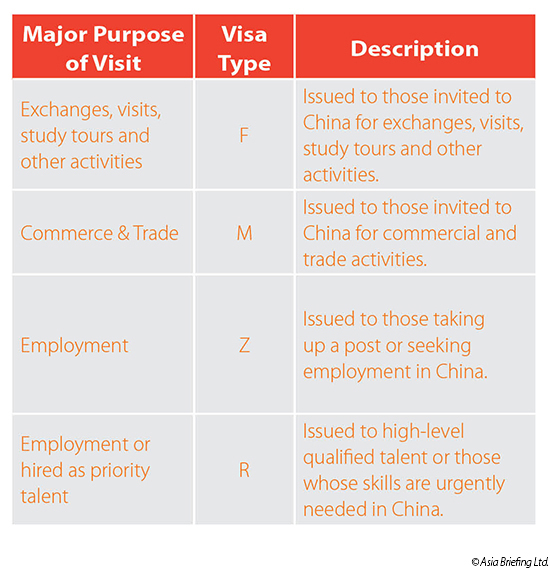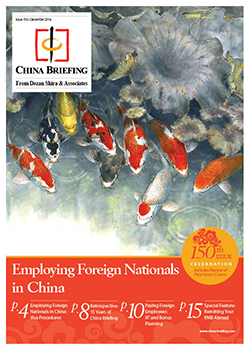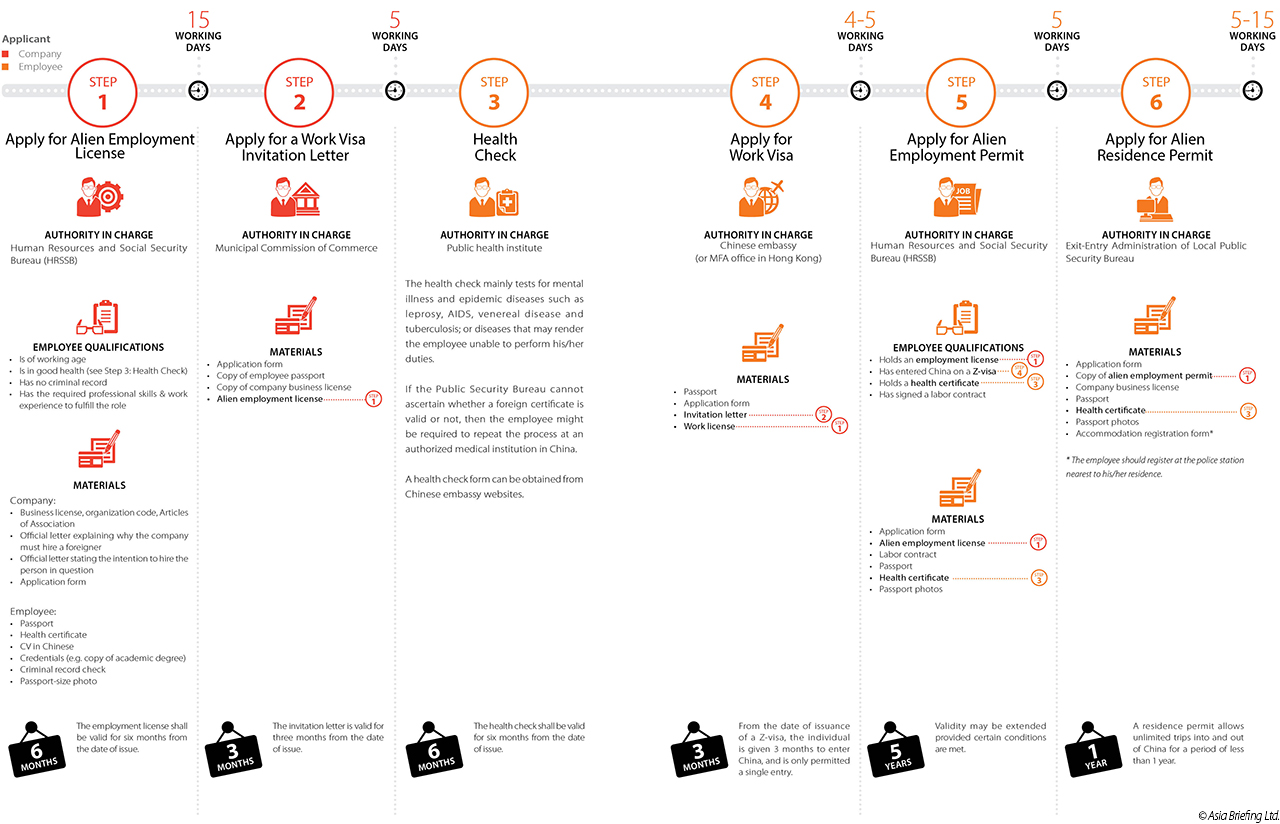Employing Foreign Nationals in China: Visa Procedures
By Zhou Qian and Steven Elsinga
In September 2013, the Chinese government amended its visa regulations. The revised law mainly introduced a number of new visa categories, increasing the total number from eight to 12, and altered the scope of a few existing categories. In this section, we walk you through the most recent changes.
The F-visa, also known as a business visa, was previously used by foreign businesspeople visiting China on business but who were not employed by a Chinese entity. However, the new regulations have now limited its scope to non-commercial purposes only, such as cultural exchanges, visits and inspections. At the same time, the regulations introduced a new visa for business travelers called the M-visa. It is applicable to foreigners coming to the country for business and trade purposes of
no more than six months (180 days). Like the previous F-visas (business category), M-visas are most suitable for foreigners who will:
- Spend less than six months in China during any one calendar year
- Be frequently entering and leaving China
- Not hold a formal senior position at an entity based in China
- Not receive payment from a company incorporated in China
M-visas can be renewed after six months, however, there is always the risk that the immigration bureau may refuse the application. This risk grows if the foreigner has resided continuously in China over a long period of time. The immigration bureau may then conclude that such an applicant is effectively working in China.
 Another new visa type is the R-visa, which is issued to foreign high level personnel and those with special talents in shortage in China. What is meant by ‘high-level personnel’ is not yet entirely clear, but this likely refers to a company’s senior management. So apart from the Z-visa, the R-visa can now also be used for employment purposes in China. Applicants for an R-visa need to satisfy more stringent requirements than for a regular Z-visa. These requirements and the documents needed are stipulated by local government authorities, and thus vary per locality.
Another new visa type is the R-visa, which is issued to foreign high level personnel and those with special talents in shortage in China. What is meant by ‘high-level personnel’ is not yet entirely clear, but this likely refers to a company’s senior management. So apart from the Z-visa, the R-visa can now also be used for employment purposes in China. Applicants for an R-visa need to satisfy more stringent requirements than for a regular Z-visa. These requirements and the documents needed are stipulated by local government authorities, and thus vary per locality.
Both the R and Z-visas are official work visas. For the time being, the Z-visa is the most common type used by foreigners working in China, and will likely remain so, considering the stricter requirements and remaining uncertainty regarding the R-visa.
An employee on a Z-visa needs to subsequently apply for a residence permit. The residence permit allows the foreigner to stay in China for the length of time as stipulated by the permit, usually one year. It also allows him/her an unlimited number of trips into and out of the country. With an M-visa (or the previous F-visa) this is not possible, and leaving the country often means having to reapply for a new visa.
The full procedure for obtaining a work visa (Type Z) is summarized in the chart below (click for large).
The new law also introduces the concept of a ‘private non-enterprise unit’. Foreigners working for such organizations need to apply for a Foreign Expert Certificate, instead of an Alien Employment Permit. We will go into more detail about these documents in the following pages. Depending on how the implementation of the new regulations proceed, foreigners working for ‘private non-enterprise units’ may soon have to apply for R-visas instead of Z-visas.
For a consultation on the different types of visas available to foreign nationals in China, or other types of Human Resource advisory, please contact the tax, legal and operational professionals of Dezan Shira & Associates at china@dezshira.com.
 This article is an excerpt from the December issue of China Briefing Magazine, titled “Employing Foreign Nationals in China“. In this issue of China Briefing, we have set out to produce a guide to employing foreign nationals in China, from the initial step of applying for work visas, to more advanced subjects such as determining IIT liability and optimizing employee income packages for tax efficiency. Lastly, recognizing that few foreigners immigrate to China on a permanent basis, we provide an overview of methods for remitting RMB abroad. This article is an excerpt from the December issue of China Briefing Magazine, titled “Employing Foreign Nationals in China“. In this issue of China Briefing, we have set out to produce a guide to employing foreign nationals in China, from the initial step of applying for work visas, to more advanced subjects such as determining IIT liability and optimizing employee income packages for tax efficiency. Lastly, recognizing that few foreigners immigrate to China on a permanent basis, we provide an overview of methods for remitting RMB abroad. |
![]()
 Adapting Your China WFOE to Service China’s Consumers
Adapting Your China WFOE to Service China’s Consumers
In this issue of China Briefing Magazine, we look at the challenges posed to manufacturers amidst China’s rising labor costs and stricter environmental regulations. Manufacturing WFOEs in China should adapt by expanding their business scope to include distribution and determine suitable supply chain solutions. In this regard, we will take a look at the opportunities in China’s domestic consumer market and forecast the sectors that are set to boom in the coming years.
 Industry Specific Licenses and Certifications in China
Industry Specific Licenses and Certifications in China
In this issue of China Briefing, we provide an overview of the licensing schemes for industrial products; food production, distribution and catering services; and advertising. We also introduce two important types of certification in China: the CCC and the China Energy Label (CEL). This issue will provide you with an understanding of the requirements for selling your products or services in China.
China Retail Industry Report 2014
In this special edition of China Briefing, we provide an overview of the retail industry in China and the procedures for setting up a retail shop, focusing specifically on brick-and-mortar physical retail stores. Further, we have invited our partner Direct HR to offer some insights on the talent landscape in the retail industry, as well as tips for recruiting retail personnel in China.
- Previous Article Using China’s Free Trade & Double Tax Agreements – New Issue of China Briefing Magazine
- Next Article China Releases Draft Foreign Investment Law, Signaling Major Overhaul for Foreign Investment











